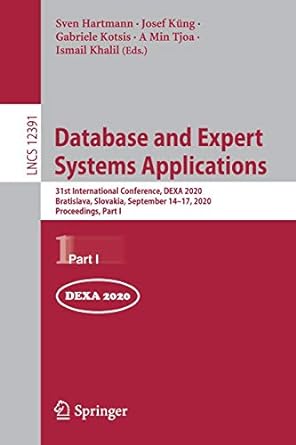Question
PYTHON help! Below is the completed stack implementation from class. While you needn't modify it for this assignment indeed, all tests run on our end
PYTHON help!
Below is the completed stack implementation from class. While you needn't modify it for this assignment indeed, all tests run on our end will *not* make use of any changes you introduce to the `Stack` class we urge you to read through the code and make sure you understand how it works.
class Stack: class Node: def __init__(self, val, next=None): self.val = val self.next = next def __init__(self): self.top = None
def push(self, val): self.top = Stack.Node(val, self.top) def pop(self): assert self.top, 'Stack is empty' val = self.top.val self.top = self.top.next return val def peek(self): return self.top.val if self.top else None def empty(self): return self.top == None def __bool__(self): return not self.empty() def __repr__(self): if not self.top: return '' return '--> ' + ', '.join(str(x) for x in self) def __iter__(self): n = self.top while n: yield n.val n = n.next
2. Infix Postfix conversion
Another function we looked at was one that used a stack to evaluate a postfix arithmetic expression you can review the code at http://moss.cs.iit.edu/cs331/notebooks/stacks-and-queues.html (look for eval_postfix). Because most of us are more accustomed to infix-form arithmetic expressions (e.g., 2 * (3 + 4)), however, the function seems to be of limited use. The good news: we can use a stack to convert an infix expression to postfix form!
To do so, we will use the following algorithm:
Start with an empty list and an empty stack. At the end of the algorithm, the list will contain the correctly ordered tokens of the postfix expression.
Next, for each token in the expression (split on whitespace):
if the token is a digit (the string isdigit method can be used to determine this), simply append it to the list; else, the token must be either an operator or an opening or closing parenthesis, in which case apply one of the following options:
if the stack is empty or contains a left parenthesis on top, push the token onto the stack.
if the token is a left parenthesis, push it on the stack.
if the token is a right parenthesis, pop the stack and append all operators to the list until a left parenthesis is popped. Discard the pair of parentheses.
if the token has higher precedence than the top of the stack, push it on the stack. For our purposes, the only operators are +, -, *, /, where the latter two have higher precedecence than the first two.
if the token has equal precedence with the top of the stack, pop and append the top of the stack to the list and then push the incoming operator.
if the incoming symbol has lower precedence than the symbol on the top of the stack, pop the stack and append it to the list. Then repeat the above tests against the new top of stack.
After arriving at the end of the expression, pop and append all operators on the stack to the list.
# you may find the following precedence dictionary useful prec = {'*': 2, '/': 2, '+': 1, '-': 1}
def infix_to_postfix(expr): """Returns the postfix form of the infix expression found in `expr`""" ops = Stack() postfix = [] toks = expr.split()
#YOUR CODE HERE
return ' '.join(postfix)
TEST CASES
# (3 points)
from unittest import TestCase tc = TestCase() tc.assertEqual(infix_to_postfix('1'), '1') tc.assertEqual(infix_to_postfix('1 + 2'), '1 2 +') tc.assertEqual(infix_to_postfix('( 1 + 2 )'), '1 2 +') tc.assertEqual(infix_to_postfix('1 + 2 - 3'), '1 2 + 3 -') tc.assertEqual(infix_to_postfix('1 + ( 2 - 3 )'), '1 2 3 - +')
# (3 points)
from unittest import TestCase tc = TestCase() tc.assertEqual(infix_to_postfix('1 + 2 * 3'), '1 2 3 * +') tc.assertEqual(infix_to_postfix('1 / 2 + 3 * 4'), '1 2 / 3 4 * +') tc.assertEqual(infix_to_postfix('1 * 2 * 3 + 4'), '1 2 * 3 * 4 +') tc.assertEqual(infix_to_postfix('1 + 2 * 3 * 4'), '1 2 3 * 4 * +')
# (3 points)
from unittest import TestCase tc = TestCase() tc.assertEqual(infix_to_postfix('1 * ( 2 + 3 ) * 4'), '1 2 3 + * 4 *') tc.assertEqual(infix_to_postfix('1 * ( 2 + 3 * 4 ) + 5'), '1 2 3 4 * + * 5 +') tc.assertEqual(infix_to_postfix('1 * ( ( 2 + 3 ) * 4 ) * ( 5 - 6 )'), '1 2 3 + 4 * * 5 6 - *')
Step by Step Solution
There are 3 Steps involved in it
Step: 1

Get Instant Access to Expert-Tailored Solutions
See step-by-step solutions with expert insights and AI powered tools for academic success
Step: 2

Step: 3

Ace Your Homework with AI
Get the answers you need in no time with our AI-driven, step-by-step assistance
Get Started


